We propose a new type of the lattice-gas (LG) model, where the atoms may be in two different states: the immobile state, in which they jump as usual in the LG model, and the running state, in which the atoms always jump in the driving direction. The model demonstrates a typical behavior of traffic-jam models: the system splits into domains of immobile atoms (jams) and running atoms. We considered a one-dimensional (1D) LG model and also four variants of the two-dimensional (2D) LG model, namely the multi-lane and truly-2D models with passive and active atomic jumps. The 2D model is characterized by the steady state with a power law distribution of jam sizes with the universal exponent 3/2. The phase diagram of the model shows that the mobility of the 2D system is lower than the mobility of the 1D model due to spreading of jams in the direction transverse to the driving direction.
Dimensionless concentration: θ = N/M, where N is the number of atoms and M is the number of sites (N<M).
Hard-core interaction (Langmuir model): each site is either empty or occupied by one atom.
The LG model describes the overdamped dynamics at low temperatures T (T << ε).

The driven LG model:

|
LG model: γ+= γα and γ–= γ(1–α), where 0.5 < α < 1; α≈aF/kBT so that J ~ γ+– γ–
Underdamped system: inertia effects → bistability & hysteresis.
In the bistable region, two states: “immobile” and “running”. At jump, immobile → running
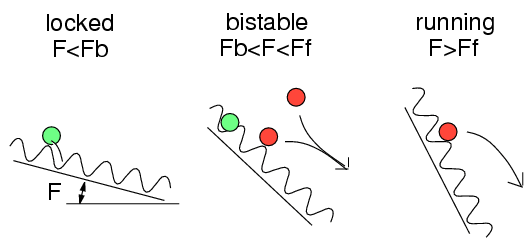
immobile
(locked) state
|
running
(sliding) state
|
|
|
|
rule: immobile → running (jump to empty state) |
rule: running → immobile (collision with immobile atom) |
 |
 |
|
atomic trajectories versus time |
Two-state lattice-gas model: immobile atoms in black, running atoms in grey |
 |
 |
Details of simulation for the FK model: we used Langevin motion equations,
|
Let us define a dimensionless "mobility" B=Nr/N, where Nr is the number of running atoms. Then
|
(*) |
and B=1 for α>θ

Proof: Let there is only
a sigle jam of the length s. Local concentration in the jam is
θs=1, the length of the running
domain (RD) is
Mr. Then we maylet us use a simple arithmetic:
Distribution of jam's sizes: P(s) ~ exp(−s2/4αt) for s>>1 and t>>1
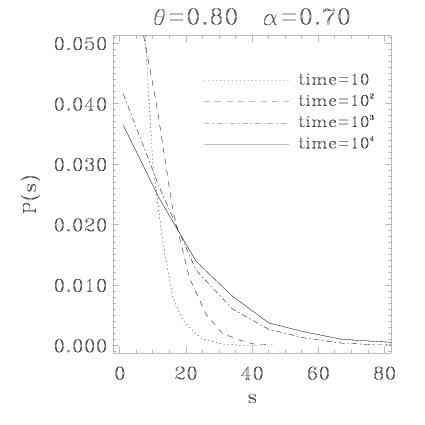
Conclusion for the 1D model:
for
θ>α
there always exist traffic jams,
B<1, due to:
concurrent
processes:
|
{
|
(a)(a) detour
TJs
→
B(2D) > B(1D)
|
|
| (b) creation of new TJs
→
B(2D) < B(1D)
|
|
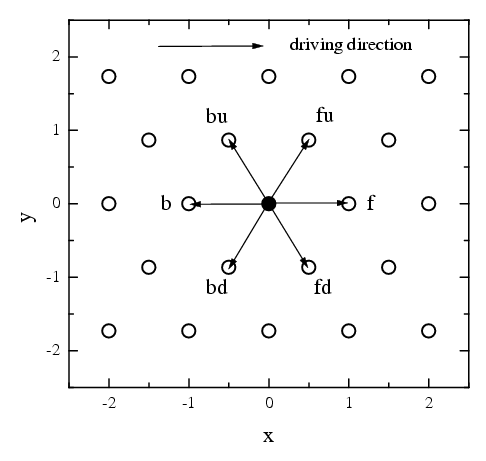 |
f = forward
b = backward
u = up
d = down
|
|
Use: αf=α0c2, αfu=αfd=α0c, αb=α0/c2, αbu=αbd=α0/c, where c~exp(aF/2T).
Normalization: αf + αfu+ αfd + αb + αbu + αbd = 1
Define: the total probability of the jump in the driving direction is α = αf + αfu + αfd
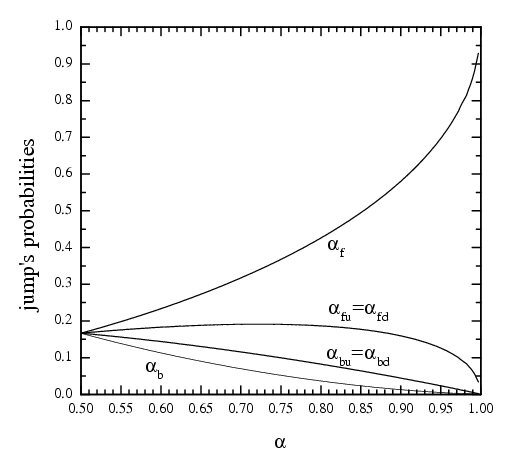
1. Each atom may be either in an immobile state or in the running state.
2. At each time step t → t+1, one chooses at random a site i.
3. If this site is occupied by immobile atom, it jumps to one of six neighboring sites with
a corresponding probability, provided the chosen site is empty.
After the jump to one of three backward (left-hand side, i.e., b, bu, bd) directions
the atom remains in the immobile state, while
after the jump to the right (in the f-, fu-, or fd-direction)
the atom is in the running state.
4. If the atom in the chosen site i is in the running state, it jumps to the right
provided the right-hand site is empty, and remains in the running state.
Otherwise, if the right-hand site is not empty, the atom may either remain in the running state or it may
become immobile if the right-hand site is occupied by the immobile atom.
5. Use periodic boundary conditions & sequential dynamics.
6. Four different variants: multilane model ↔ truly-2D model
passive jumps ↔ active jumps
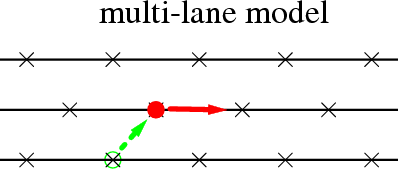 |
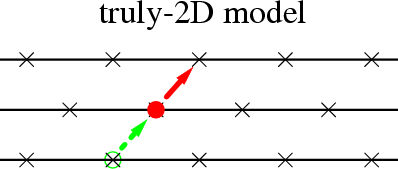 |
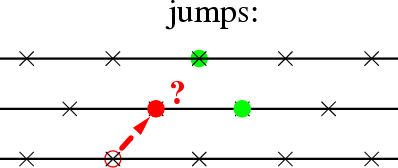 |
/ |
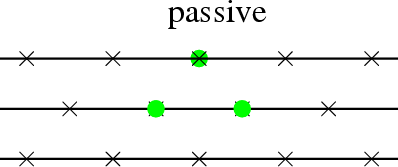 |
| \ |
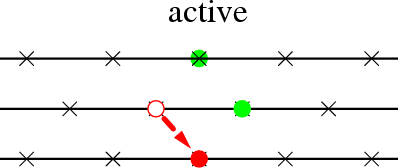 |
Example: multi-lane model with active jumps for α=0.75, θ=0.8 (see this figure enlarged)
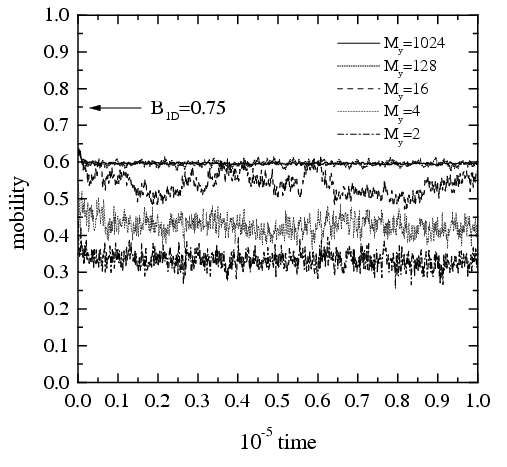
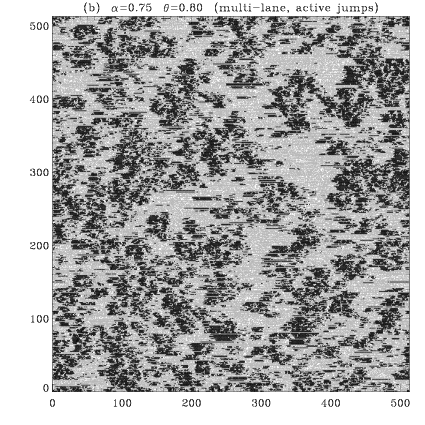
short time scale (Δt=1) animated gif 3.3 Mb
long time scale (Δt=10) animated gif 5 Mb
both for multi-lane model with active jumps for α=0.75 and θ=0.8 (lattice 512x512, tini=105)
immobile atoms in green, running atoms in red
The 2D system has the truly steady state with a power law
distribution of jam sizes characterized by the universal exponent 3/2:
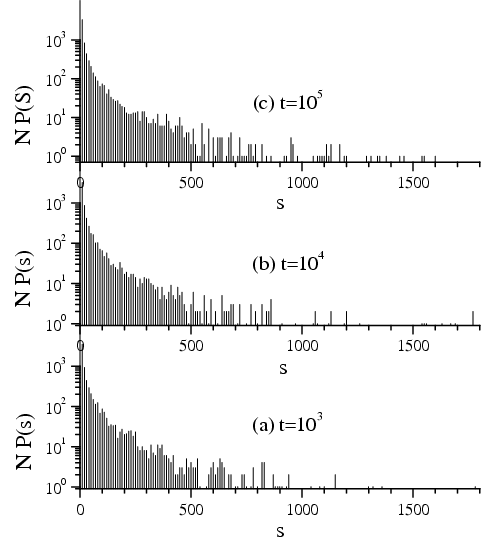 |
Histogram of size
distribution of immobile islands for the multi-lane model with active
jumps at three times (t=103,
104 and
105) for
α=0.75,
θ=0.8,
Mx=My=1024
(enlarged view)
|
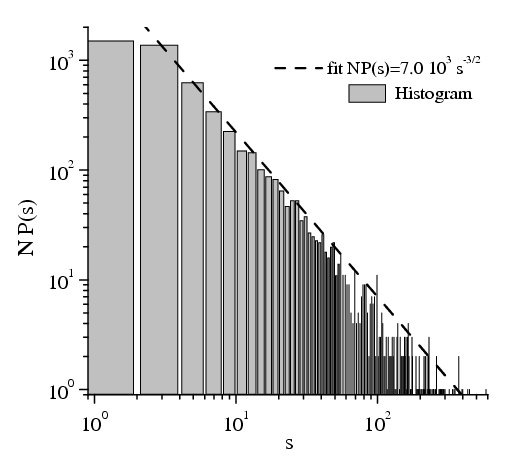 |
Histograms for other parameters of the model are the following:
multilane model with passive jumps:
alpha=0.55, theta=0.50, file=lmpas-f.gif
alpha=0.55, theta=0.70, file=lmpas-d.gif
alpha=0.75, theta=0.70, file=lmpas-b.gif
alpha=0.75, theta=0.80, file=lmpas-a.gif
alpha=0.95, theta=0.88, file=lmpas-h.gif
multilane model with active jumps:
alpha=0.55, theta=0.50, file=lmact-f.gif
alpha=0.75, theta=0.70, file=lmact-b.gif
alpha=0.75, theta=0.80, file=lmact-a.gif
alpha=0.95, theta=0.88, file=lmact-h.gif
alpha=0.95, theta=0.90, file=lmact-e.gif
truly 2D model with passive jumps:
alpha=0.55, theta=0.50, file=2dpas-f.gif
alpha=0.55, theta=0.70, file=2dpas-d.gif
alpha=0.55, theta=0.90, file=2dpas-g.gif
alpha=0.75, theta=0.60, file=2dpas-j.gif
alpha=0.75, theta=0.70, file=2dpas-b.gif
alpha=0.75, theta=0.80, file=2dpas-a.gif
alpha=0.75, theta=0.90, file=2dpas-c.gif
alpha=0.95, theta=0.70, file=2dpas-k.gif
alpha=0.95, theta=0.80, file=2dpas-l.gif
alpha=0.95, theta=0.88, file=2dpas-h.gif
alpha=0.95, theta=0.90, file=2dpas-e.gif
alpha=0.95, theta=0.94, file=2dpas-i.gif
truly 2D model with active jumps:
alpha=0.55, theta=0.62, file=2dact-m.gif
alpha=0.55, theta=0.70, file=2dact-g.gif
alpha=0.75, theta=0.70, file=2dact-b.gif
alpha=0.75, theta=0.80, file=2dact-a.gif
alpha=0.75, theta=0.90, file=2dact-c.gif
alpha=0.95, theta=0.74, file=2dact-n.gif
alpha=0.95, theta=0.80, file=2dact-l.gif
alpha=0.95, theta=0.88, file=2dact-h.gif
alpha=0.95, theta=0.90, file=2dact-e.gif
alpha=0.95, theta=0.94, file=2dact-i.gif
|
The steady state must satisfy the equation ΔPt(s)=0. Suppose that
(a) the rate of coalescence does not
depend on the sizes of colliding islands,
(b) R(s, k)
depends on the size of the island only,
In this case R(s) should behave as R(s) ~ (s–1)–1 for s >> 1.
Proof: substituting T(s, k)=T0 and R(s, k)=R(s) into the master equation for the steady state,
we can rewrite it in the form
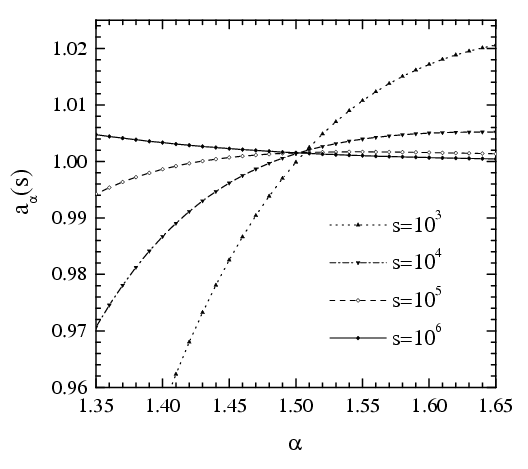
Snapshot configurations at t=105 of the multi-lane model with active jumps (lattice 512 × 512) for different model parameters. Iimmobile atoms in black, running atoms in grey
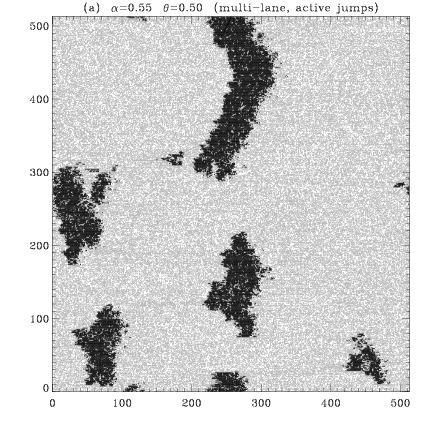 |
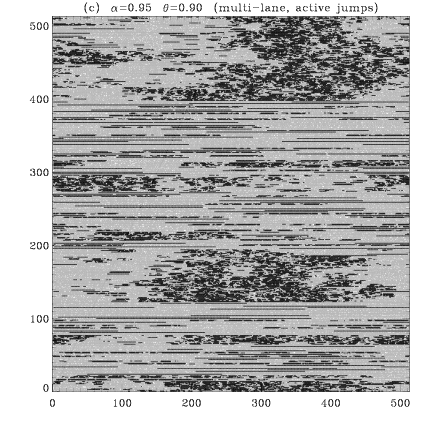 |
|
(a) α = 0.55, θ = 0.5, B ≈ 0.8 (low forcing) |
(c) α = 0.95, θ = 0.9, B ≈ 0.7 (high forcing) |
B(multi-lane) > B(truly 2D) in most cases, and B(active) > B(passive)
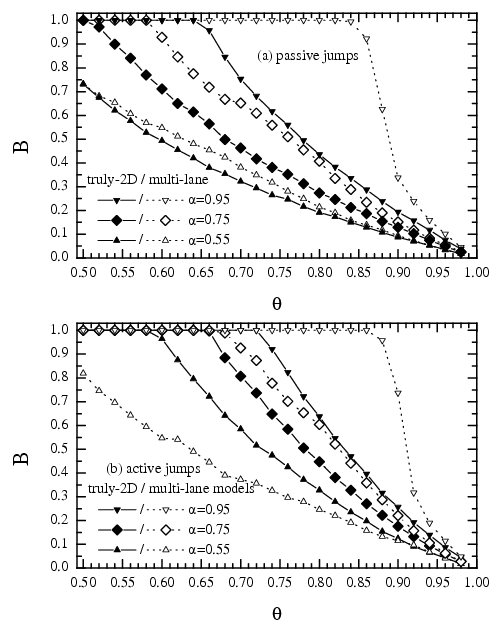 |
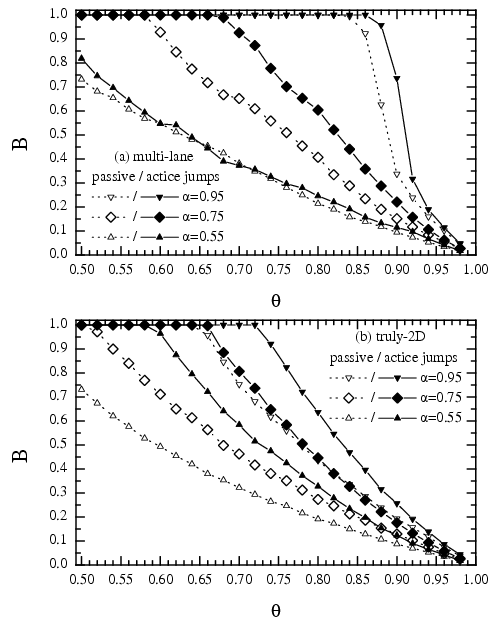 |
| enlarged view | enlarged view |
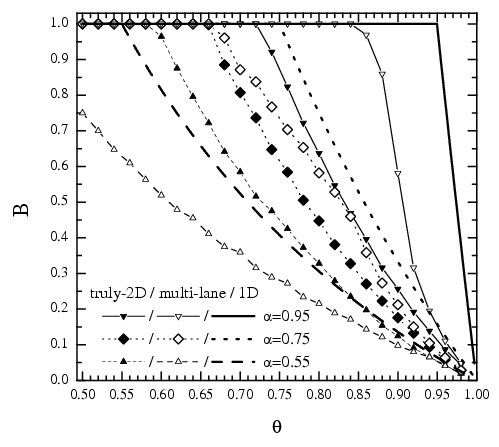
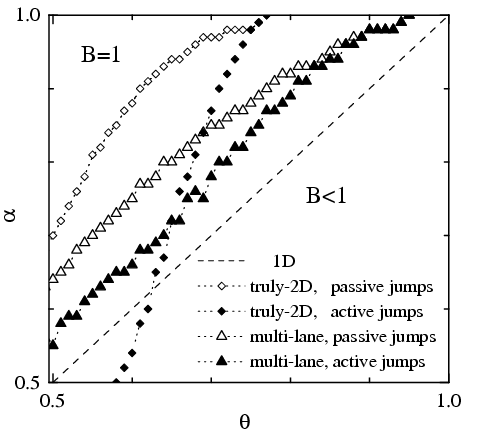
The 1D model: when θ > α, then the traffic jams exist always, B < 1, due to (a) randomness and (b) hard-core interaction. The 1D model has no stationary state (although B=const).
The 2D model has a truly steady state with a power-law distribution of jam sizes characterized by the universal exponent 3/2. Typically B(1D) > B(2D).
Receipts to avoid traffic jams:
(a) reduce the concentration θ;
(b) try to keep equidistance;
(c) use one-lane roads (or forbid lane changing on the multilane road).
See Oleg Braun and Bambi Hu, J. Stat. Phys. 92 (1998) 629 "Traffic jams in a lattice-gas model" and Phys. Rev. E 71 (2005) 031111 "Two-dimensional two-state lattice-gas model" (pdf files may be found here)
Last updated on September 26, 2008 by Oleg Braun. Translated from LATEX by TTH